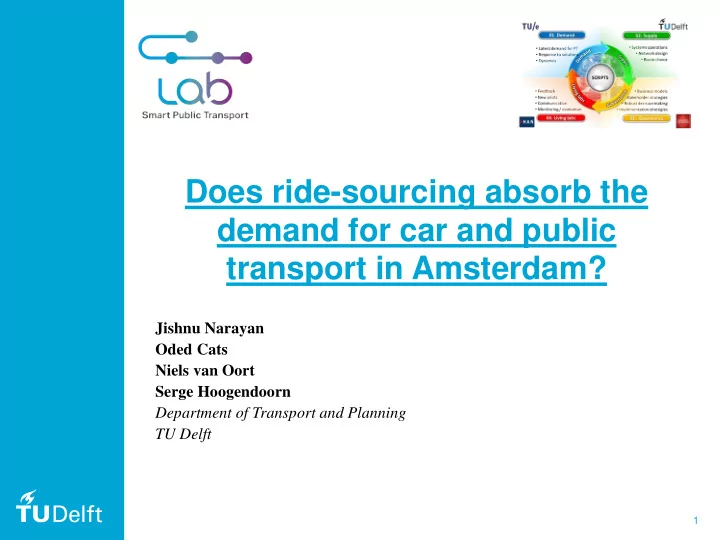

Does ride-sourcing absorb the demand for car and public transport in Amsterdam? Jishnu Narayan Oded Cats Niels van Oort Serge Hoogendoorn Department of Transport and Planning TU Delft 1
Structure • Mobility trends and objective • Modelling framework • Amsterdam scenario • Simulation scenarios • Results and Conclusion 2
Mobility trends worldwide Advancements in ICT Rise of on-demand services User operator interaction Flexibility of travel 3
Mobility trends worldwide Car and public transport increasingly lose their share Timely to assess the potential of such services 4
Ride-sourcing service replacing private cars 5
Modelling framework 6
Agent based simulation model for Amsterdam Agent based simulation model Amsterdam network • Users as agents • 168,103 people • Autonomous decision making • 17,375 nodes • 31,502 links • Activity based travel plan • 2,517 public transport stops • One iteration = one day 7
Service definition Public transport Ride-sourcing services • Real time requests (no pre booking) • Offers door-to-door service • Private taxi like service Dispatching unit Privately owned cars Active modes 8
Scenarios considered Base case Ride-sourcing vehicles enter the system Fleet size to provide similar Fleet size to provide similar los as PT trips los as car trips 9
Fleet size to provide similar los for all PT trips 1417 (1%) vehicles is able to achieve door-to-door travel time 2834 (2%) vehicles is able to achieve stop-to-stop travel time 10
Impact of ride-sourcing on PT sub networks 100% PT 100% ride-sourcing Most PT users shift to ride-sourcing due to longer trips Bus and tram users mostly switch to active modes and ride-sourcing 11
Fleet size to provide similar los for all car trips 4251 vehicles (3%) is able to achieve near to similar travel time as car trips in base case The fleet size corresponds to 9.1% of cars in base cases 12
Key findings Base case 21% 22% 28% 29% Fleet of ride-sourcing vehicles is introduced How many vehicles to How many vehicles are provide similar los as car? required to provide similar los as PT? 4251 vehicles 1417 vehicles Total travel time Door-to-door travel 3% of total time 1.3% of PT trips demand 1:9 Replacement ratio 2834 vehicles Stop-to-stop travel time 2.7% of PT trips 13
Future direction • Impact of a simultaneously shared service • Multiple ride-sourcing operators • Impact of cost on market share of users 14
Thank you!!! 15
Recommend
More recommend